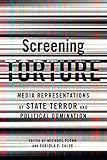Screening Torture : Media Representations of State Terror and Political Domination / Michael Flynn, Fabiola Fernandez Salek.
Material type: TextPublisher: New York, NY : Columbia University Press, [2012]Copyright date: ©2012Description: 1 online resource (328 p.) : ‹B›Color Photos: ‹/B›17Content type:
TextPublisher: New York, NY : Columbia University Press, [2012]Copyright date: ©2012Description: 1 online resource (328 p.) : ‹B›Color Photos: ‹/B›17Content type: - 9780231153591
- 9780231526975
- 791.436352 23
- PN1995.9.T67 S37 2012
- PN1995.9.T67 S37 2015
- online - DeGruyter
- Issued also in print.
| Item type | Current library | Call number | URL | Status | Notes | Barcode | |
|---|---|---|---|---|---|---|---|
 eBook
eBook
|
Biblioteca "Angelicum" Pont. Univ. S.Tommaso d'Aquino Nuvola online | online - DeGruyter (Browse shelf(Opens below)) | Online access | Not for loan (Accesso limitato) | Accesso per gli utenti autorizzati / Access for authorized users | (dgr)9780231526975 |
Browsing Biblioteca "Angelicum" Pont. Univ. S.Tommaso d'Aquino shelves, Shelving location: Nuvola online Close shelf browser (Hides shelf browser)

|

|

|

|

|

|

|
||
| online - DeGruyter No Return, No Refuge : Rites and Rights in Minority Repatriation / | online - DeGruyter The Kitchen as Laboratory : Reflections on the Science of Food and Cooking / | online - DeGruyter Cheese, Pears, and History in a Proverb / | online - DeGruyter Screening Torture : Media Representations of State Terror and Political Domination / | online - DeGruyter They Wished They Were Honest : The Knapp Commission and New York City Police Corruption / | online - DeGruyter The Quest for God and the Good : World Philosophy as a Living Experience / | online - DeGruyter Acts of God and Man : Ruminations on Risk and Insurance / |
Frontmatter -- Contents -- Screening Torture -- Part I: Torture and the Implications of Masculinity -- 1. Countering the Jack Bauer Effect -- 2. Mel Gibson's Tortured Heroes -- 3. It's a Perfect World -- Part II: Torture and the Sadomasochistic Impulse -- 4. Lust, Caution -- 5. The Art of Photogenic Torture -- 6. Beyond Susan Sontag -- 7. Stanley Kubrick's A Clockwork Orange as Art Against Torture -- Part III: Confronting the Legacies of Torture and State Terror -- 8. "Accorded a Place in the Design" -- 9. Confessing Without Regret -- PART IV: Torture and the Shortcomings of Film -- 10. Movies of Modern Torture as Convenient Truths -- 11. Torture at the Limit of Politics -- 12. Doing Torture in Film -- 13. Documenting the Documentaries on Abu Ghraib -- Contributors -- Index
restricted access online access with authorization star
http://purl.org/coar/access_right/c_16ec
Before 9/11, films addressing torture outside of the horror/slasher genre depicted the practice in a variety of forms. In most cases, torture was cast as the act of a desperate and depraved individual, and the viewer was more likely to identify with the victim rather than the torturer. Since the terrorist attacks of September 11, 2001, scenes of brutality and torture in mainstream comedies, dramatic narratives, and action films appear for little other reason than to titillate and delight. In these films, torture is devoid of any redeeming qualities, represented as an exercise in brutal senselessness carried out by authoritarian regimes and institutions.This volume follows the shift in the representation of torture over the past decade, specifically in documentary, action, and political films. It traces and compares the development of this trend in films from the United States, Europe, China, Latin America, South Africa, and the Middle East. Featuring essays by sociologists, psychologists, historians, journalists, and specialists in film and cultural studies, the collection approaches the representation of torture in film and television from multiple angles and disciplines, connecting its aesthetics and practices to the dynamic of state terror and political domination.
Issued also in print.
Mode of access: Internet via World Wide Web.
In English.
Description based on online resource; title from PDF title page (publisher's Web site, viewed 02. Mrz 2022)


